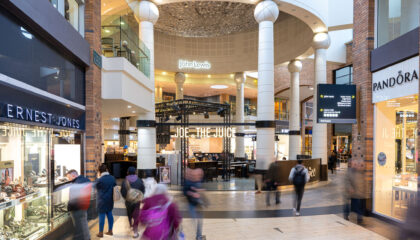Living walls, green roofs and other urban greening initiatives can directly benefit the bottom line, writes Vicky Cotton, ESG Director, in CoStar.
News that Canary Wharf Group has enlisted world-renowned social enterprise The Eden Project in a bid to lure office workers back to their desks is hardly surprising given our lockdown-driven appreciation for green spaces and urban parks.
After all, who wants to swap their leafy suburban home office for a jungle made of concrete and glass?
London’s financial district’s “green spine” plan incorporates parks, open-water swimming access, paddleboarding, and a waterside pavilion for concerts. However, this biodiversity-focused blueprint isn’t merely an environmental, social, and corporate governance vanity project. It significantly aligns with our industry’s recognition of the commercial benefits tied to urban greening initiatives.
Strategic implementation of living walls, green roofs, and pocket parks during redesign or refurbishment adds tangible value to a firm’s portfolio. Keeping the commercial benefits of urban greening in focus, we aim to enhance biodiversity across the assets we manage. This includes Arlington Business Park, spanning 380,000 sq. feet, and Regal House, a 14,000-square-foot office building in London’s Covent Garden. Our biodiversity strategies encompass carbon-consuming and aesthetically pleasing interventions. These range from beehives, bat boxes, wildflower meadows, to rooftop allotments, and living green walls.
The potential outcomes and benefits are extensively documented and varied. These include reducing heat and energy loss, enhancing air quality and circulation, and minimising air temperature fluctuations. Going beyond the immediate aesthetic enhancement of green spaces, strategically implementing biodiversity programs will create significantly improved places. Occupiers and their employees will opt to spend their time in such environments.
Benefits to business and society
The UK Green Building Council’s report, “Nature-based solutions for the climate emergency” shows a 40% increase in commercial trading rates. This is following investment in a well-planned green space such as a local park. The addition of street trees, for example, can deliver a 7% increase in property value, along with up to 50% increase in restaurant patronage and “willingness to spend.”
Urban greening additions not only boost revenue but also cut down portfolio-wide expenses, aligning with net-zero goals. Green walls and roofs offer additional insulation to assets, minimising energy usage for heating and cooling. Moreover, they extend a roof’s structural lifespan significantly compared to conventional designs, acting as a safeguard.
Revenue benefits can be observed from assets such as Harrogate’s Rudding Park Hotel, where CoStar sister publication Hotel News Now recently reported on the integration of a roof garden into the hotel’s design, designed to bolster the hotel’s revenue streams. Despite the structural modifications required to support the garden’s weight, investing in a rooftop hospitality venue proved highly lucrative. It generated between £50,000 and £60,000 per month in beverage revenue alone.
Championing urban greening solutions
Westminster is progressing towards its 25-Year Environment Plan, advocating a 10% boost in biodiversity for new developments. This underscores the Department for Levelling Up Housing and Communities’ policy priority of fostering greater biodiversity within urban settings.
In reality, however, 80% of the buildings that will be in use in 2050 already exist today. The property industry is, therefore, rightly looking beyond new-builds, by recognising that the greatest opportunity nature-based solutions provide is in the retrofitting of existing assets.
During the pandemic, work patterns changed, with employees placing greater importance on connecting with the outdoors. Urban greening features have emerged as a significant attraction for employers to retain and attract talent. With regular exercise and outdoor meetings becoming the norm, occupiers understand the benefits of incorporating nature into thoughtfully designed work environments.
A time may soon come where the absence of green space becomes an active deterrent for the modern workforce, potentially reducing an occupier’s talent pool further. A sobering thought amidst the “great resignation” and in a period of acute talent shortages.
While the business and economic rationale speaks for itself, the climate crisis adds an urgency to expediting urban greening and biodiversity in the built world. We’re certainly seeing this play out across our varied client base; a sign of hope, as the old Greek proverb goes, for a society that “grows great when we plant trees in whose shade we shall never sit.”
By Vicky Cotton, ESG Services Director at Workman



